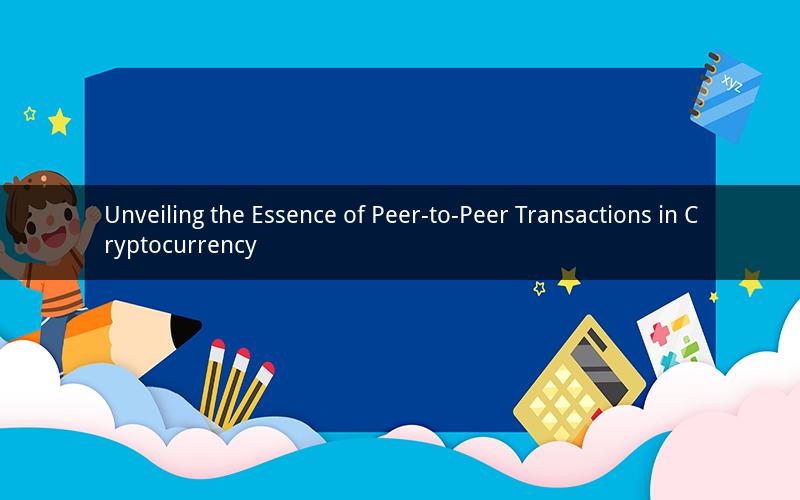
In the rapidly evolving world of digital currencies, peer-to-peer (P2P) transactions have become a cornerstone of the cryptocurrency ecosystem. P2P transactions refer to direct transactions between two parties without the need for a centralized authority. This innovative approach has revolutionized the way individuals and businesses engage in financial transactions. This article delves into the concept of P2P transactions in cryptocurrency, exploring its significance, benefits, and potential challenges.
Understanding Peer-to-Peer Transactions
At its core, a P2P transaction is a direct exchange of value between two parties without the involvement of a third party. In the context of cryptocurrency, P2P transactions occur when individuals or entities exchange digital currencies, such as Bitcoin, Ethereum, or Litecoin, with each other. Unlike traditional banking systems, P2P transactions eliminate the need for intermediaries like banks or payment processors.
The P2P transaction process involves the following steps:
1. The buyer initiates the transaction by sending a request to the seller.
2. The seller receives the request and confirms the transaction details.
3. The buyer transfers the cryptocurrency to the seller's wallet address.
4. The seller receives the cryptocurrency and confirms the transaction.
5. The transaction is recorded on the blockchain and becomes immutable.
Benefits of P2P Transactions in Cryptocurrency
P2P transactions offer several advantages over traditional banking systems, making them a popular choice among cryptocurrency users:
1. Lower transaction fees: P2P transactions typically incur lower fees compared to traditional banking systems. This is because they eliminate the need for intermediaries, reducing overhead costs.
2. Faster transaction speeds: P2P transactions are generally faster than traditional bank transfers. This is because they do not require the time-consuming processes involved in intermediaries' verification and processing.
3. Enhanced privacy: P2P transactions do not require the disclosure of personal or financial information to third parties, providing users with greater privacy and security.
4. Accessibility: P2P transactions can be conducted from anywhere in the world, as long as both parties have access to the internet and a compatible wallet.
5. Direct control: Users have complete control over their funds during a P2P transaction, as they do not rely on intermediaries to manage their assets.
Challenges of P2P Transactions in Cryptocurrency
Despite their numerous benefits, P2P transactions in cryptocurrency also come with certain challenges:
1. Security risks: P2P transactions are susceptible to security risks, such as phishing scams and wallet vulnerabilities. Users must exercise caution when sharing their wallet addresses or engaging in transactions.
2. Lack of regulatory oversight: P2P transactions operate outside the regulatory framework of traditional banking systems, which can lead to legal and regulatory uncertainties.
3. Counterparty risk: P2P transactions involve direct interactions with other parties, which can result in disputes or failed transactions if one party fails to honor the agreement.
4. Volatility: Cryptocurrency prices can be highly volatile, which can impact the value of P2P transactions and create uncertainty for both buyers and sellers.
5. Limited acceptance: While P2P transactions are increasingly popular, their acceptance is still limited compared to traditional banking systems.
Frequently Asked Questions (FAQs)
1. What is the difference between P2P transactions and traditional bank transfers?
P2P transactions involve direct exchanges between two parties without intermediaries, while traditional bank transfers require the involvement of a financial institution.
2. Are P2P transactions secure?
P2P transactions can be secure if users take appropriate precautions, such as using secure wallets and verifying the legitimacy of counterparties.
3. Can P2P transactions be reversed?
P2P transactions are generally irreversible once they are confirmed on the blockchain. However, users can attempt to resolve disputes through communication with the counterparty.
4. What are the risks associated with P2P transactions?
The risks include security vulnerabilities, lack of regulatory oversight, counterparty risk, volatility, and limited acceptance.
5. How can I ensure the security of my P2P transactions?
To ensure the security of your P2P transactions, use secure wallets, verify the legitimacy of counterparties, and exercise caution when sharing personal information.
In conclusion, P2P transactions in cryptocurrency have transformed the way individuals and businesses engage in financial transactions. While they offer numerous benefits, users must be aware of the associated challenges and take appropriate precautions to ensure a secure and successful transaction experience.